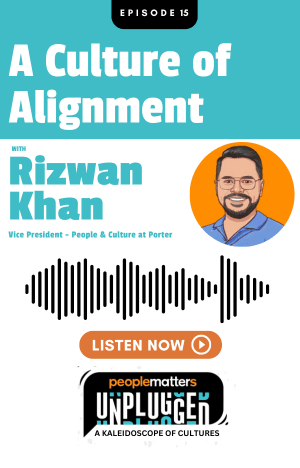No gender equity without significant male engagement, says Davinia Simon of Stax

A significant gender bias persists in the technology industry even now, due to the daily challenges such as gender inequality, unconscious bias, and under-representation faced by women. Take Australia for example - according to the Australian Computer Society’s Digital Pulse 2021 report, women hold only approximately 29% of technology jobs in the country.
Pushing for diversity and inclusion is an important societal issue but it’s also important for the business world too.
Davinia Simon, Head of Sales and Growth Markets at Australian cloud management platform Stax, says greater diversity in the workforce equates to a greater range of opinions and experiences so it’s an important business asset – especially as all come together to build and teach newer technologies like artificial intelligence (AI) and machine learning – making it a win-win for everyone.
During an interaction with People Matters, Simon says the future of tech must be diverse, inclusive, and accessible and provides her insights about fostering and celebrating diversity and inclusion, and breaking the bias in the tech industry.
Following are some excerpts.
What are your top three DEI priorities for 2022?
In 2022, we are committed to making progress to advance diversity, equity and inclusion within our organisation in three main ways:
Committing and continuing to review our strategies and policies with a lens on fostering and celebrating diversity and inclusion, and enabling our team to bring their whole selves to work.
Having a family-first focused culture, prioritising people over profit. We offer flexible work arrangements to all our employees, whether that is work hours or allowing our employees to work from anywhere. We don’t encourage our teams to work late or on the weekend. Rest and time with family and friends are important in helping you to do your job well.
Offering a range of support for our employees despite their gender. This includes 12 weeks of paid parental leave which our employees can access in the first year of a new child’s life, regardless of whether they are the primary carer, or not. This can be taken in one block, or in smaller allotments.
How can the tech industry break the bias when it comes to gender parity?
The tech sector is making significant efforts to overcome the lack of diversity we’ve historically seen across the industry, but there is still a lot more we can do. We need to create specific DEI goals, implement them, and measure and report on them – much like we do with other KPIs. We also need to ensure everyone is trained to recognise and call out both conscious and unconscious bias, and consider this in how we hire, how we train, and in the products we build.
Gender parity in the workforce is not simply about equal representation between men and women. It is about giving every person a voice and whether women within the business can equally participate, are involved in decision-making processes, and are employed in positions to influence outcomes. That last point is particularly important, as women and underrepresented communities need to have a seat at the table where company-wide decisions are made, to ensure they benefit the whole company.
Many women, particularly those who have young families or are primary carers, often face rigid working hours. This can deter them from returning to work, or from having a family in the first place – particularly given the cost of childcare and out of hours school care in many countries. The tech industry led the charge in remote working during the pandemic. Now, as we look to create a new normal, businesses across the sector must continue to deliver flexible working environments by allowing remote work and varied working hours.
What are some of the biggest challenges prolonging sustainable diversity, equity, and inclusion (DE&I)? How can organisations overcome these?
I believe unconscious bias and discrimination are the main challenges organisations face. An Australian study from Indeed found that almost 80% of Australians believe their employer would take action in the event of discrimination, but only 69% of Indigenous Australians and 66% of non-English speaking workers agree. This shows there’s still a lot of stigma and a lack of understanding associated with diverse and minority groups.
To overcome this, organisations must educate their entire workforce on stereotypes and bias, implement set criteria for evaluating qualifications and performance, and offer a safe and open space for employees to report issues without retaliation.
Whether it is age, gender or ethnicity, there is also a glaring lack of diversity within leadership teams. Having a diverse leadership team is important for business performance, better for your employees, and better for society more broadly. By giving senior opportunities to a diverse range of qualified people, you can help open the door for inclusion and representation in other facets of society.
Particular to gender diversity, how do you see the role of men in enabling and accelerating gender equity?
Gender equity won’t be achieved without significant male engagement. Given the predominance of men in leadership positions, we need their full support to make systemic changes and achieve gender equity. It should be a common goal that we all work towards.
I’ve been fortunate to have a range of fantastic mentors – both male and female – over the years, who have supported and backed me for leadership roles. Whether they’ve put me forward for promotions or helped me see the ways my strengths can be channelled to drive impactful business outcomes, they’ve been key to helping me go for bigger and better opportunities. They’ve also shown me the power of using your voice to advocate for change.
How can organisations steer clear of tokenism in their hiring and cultural transformation efforts?
Increasing diversity has a positive impact on an organisation’s culture. It can improve creativity and productivity, which, in turn, leads to greater innovation. At the same time, many employees from underrepresented communities are acutely aware of the cultural norms within organisations. If they start to suspect they’ve been hired for any reasons other than their talent and qualifications, you’re likely to lose them.
To navigate this, companies need to implement policies that consider the needs and preferences of these employees. Look to create avenues where they can express concerns or frustrations. Make it clear that if your organisation is on a journey to become more diverse and inclusive, you’re open to hearing feedback and suggestions to improve the culture and processes – so they feel supported.
How is your organisation making DE&I more sustainable in the everyday routine vs occasional awareness programs?
At Stax, we are constantly reviewing our DE&I strategies to retain and attract a more diverse pool of talent. The unique circumstances of the current labour market mean that being an inclusive, diverse, and equitable employer is a valuable differentiator in the current battle for talent.
The needs of our people are at the core of everything we do. We keep this focus by putting our people’s needs first over our commercial needs, through ongoing transparent evaluation processes, facilitating meetings where employees can have a voice about every aspect of the business – or feel comfortable sharing their feedback through group communication tools like Slack, by focusing on the work our team delivers rather than hours their logged in; and offering a flexible working environment including being able to work from anywhere.
While we have these policies and strategies in place, we also acknowledge there is still more to do – and we will continue listening to our teams and working with the wider technology sector to improve our approach to diversity, equity, and inclusion.
How can companies clear roadblocks for women who wish to pursue STEM as a career option?
Jobs in STEM are vital to innovation and economic growth and will help us navigate and overcome the many challenges facing our world. However, there is still much to do to eliminate the barriers for women who wish to pursue a career in STEM.
Resolving this starts at the beginning, and we must educate from all fronts. This includes companies engaging and working with schools, higher education providers, research institutions, citizen advocacy groups, and other businesses.
To clear these roadblocks within companies, we can start from today to:
- Be consciously inclusive, family–friendly and safe for people of all genders
- Identify and remove career penalties for those taking career breaks
- Offer flexible working environments at all levels
- Provide equal access to complex and interesting projects, training and development opportunities, formal and informal mentoring and networking opportunities
- Have clear criteria for success and evaluation processes, to further help counteract unconscious bias in assessing women and underrepresented groups’ performance.













